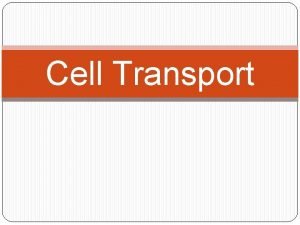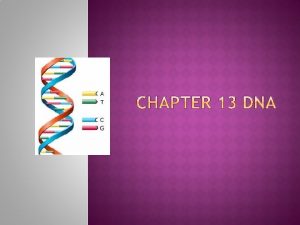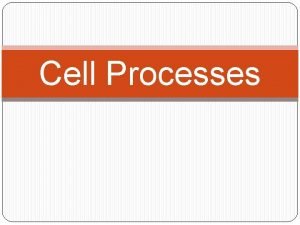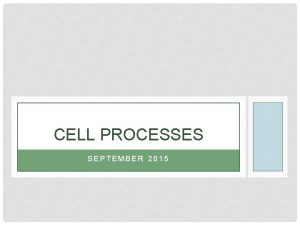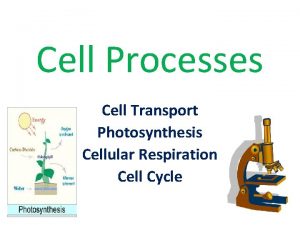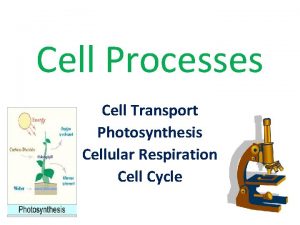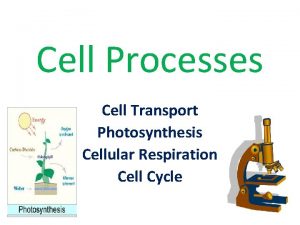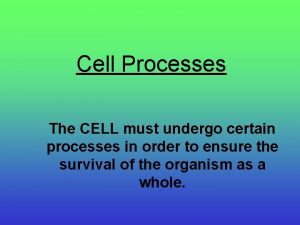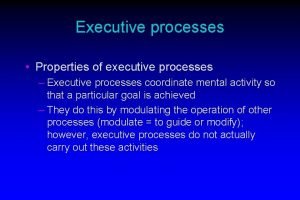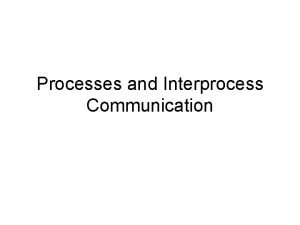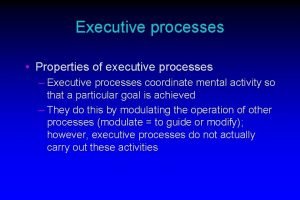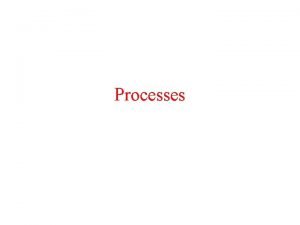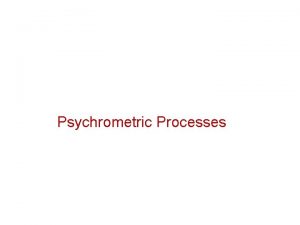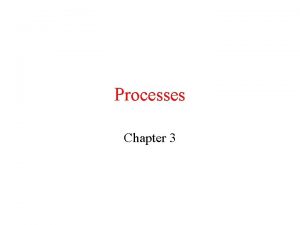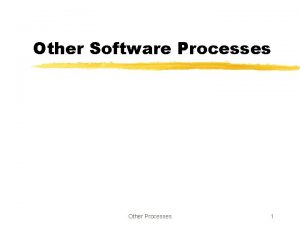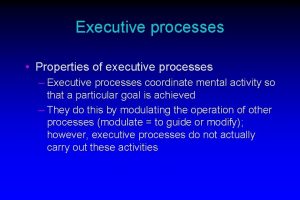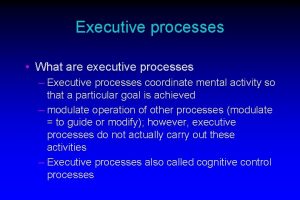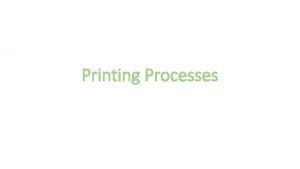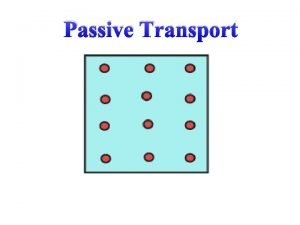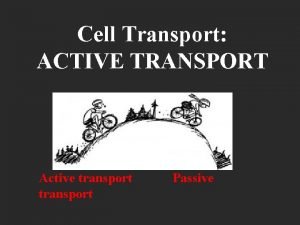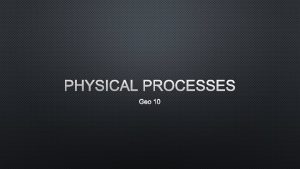Cell Processes Cell Transport Cell Transport Definition The




































- Slides: 36

Cell Processes

Cell Transport

Cell Transport Definition: The movement of substances within a cell, and the movement of substances into and out Animal of a cell. Example: Cell: Into the Cell. C 6 H 12 O 6 + Out of Cell O 2 2 + H 2 O CO 2 Types: Passive Transport & Active Transport The Simple Difference: Active transport requires energy an passive transport does not

Passive Transport Definition: • When substances moves into and out of a cell without the use of energy Requires (ATP) : • Random motion of molecules leads to dispersal 2 Types: • Diffusion • Osmosis

Diffusion Definition: • When substances move from an area of higher concentration to an area of lower concentration. What is concentration?

Equilibrium Definition: When there is an equal concentration of substances spread throughout an area or container.

Before After Low Concentratio n of Fart Molecules High Concentration Of Fart Molecules equally spread out throughout the classroom

Osmosis Definition: • A form of Passive Transport • Diffusion in water: When different concentrations of dissolved substances in water (a solution) causes water to move from one area to another 3 Types of solutions : 1. Hypertonic 2. Hypotonic 3. Isotonic

Key Points for Osmosis…. What Moves? 1. Water 2. The substance dissolved in water which can be sugar, salt, urine etc… What • Water typically moves to the Happens? dissolved substance. Example… put salt on an eggplant and water will move out of the eggplant to the salt.

1. Hypertonic Solution Before Water High conc. Inside the Low conc. Outside cell Overall Water the cell moves out of After Salt High conc. Outside Low conc. the - cellthe Inside Overall cell Salt moves into the

2. Hypotonic Solution Before Water High conc. Outside the Low conc. cell Inside the Overall Water cell moves into the After Suga r Inside High conc. the Low conc. cell Outside the Overall cell Sugar moves out of

3. Isotonic Solution Same concentration of salt/sugar inside and outside the cell. Molecules continue to move, but overall stay in equilibrium.

Osmosis in Animal Cells Details: Animal cells have a flexible membrane which can expand contract.

Osmosis in Animal Cells i n to o p Hy c ic Hy pe rto n

Osmosis in Animal Cells Hypotonic Cytolysis: The expansion of a cell due to a hypotonic solution. In some cases Hypertonic Crenation The shrinking of a cell due to a hypertonic solution.

This is a freshwater gold fish. What issues will it experience in saltwater and pure water?

Osmosis in Plant Cells Details: Different than animal cells because of a rigid outer wall known as the cell wall. The support of the cell wall prevents the plant cell from major changes in shape and size.

Osmosis in Plant Cells i n o t po Hy c ic Hy pe rto n

Osmosis in Plant Cells Hypotonic Hypertonic Turgor Pressure Plasmolysis: The expansion of the cell membrane causes the cell wall to bend outward. Helps to keep a plant The shrinking of the cell membrane causes the cell wall to bend inward. When a plant

Faciliated Diffusion Definition: • Large molecules cannot flow through the cell membrane • Transport proteins

Active Transport Definition: • When a cell uses energy to move substances. • Moving substances from an area of low concentration to an area of high concentration Example: When a paramecium excretes water from its contractile vacuole

Types of Liquids Cell Solution 94% water 2% sugar 2% wastes 2% salt • A solution of water and dissolved substances found in a “typical cell. Typically, cells have a small amount of dissolved salt, sugar, wastes, etc. . • 94% water, 6% salt, sugar, and wastes

Types of Liquids Pure Water Salt Solution • Water with no salt or other dissolved substances (100% water) • Also known as distilled water • A solution of water and salt with a high concentration of salt. (80% water, 20% salt)

What will happen in the following situation?


How are the two diagrams different How are the two diagrams the same?

Background information for lab experiments: v Molasses is a simple sugar (small molecule) v Iodine is an indicator for starch § Iodine which is yellow/orange turns starch black v Starch is a large molecule, made up of many small sugars Answer the conclusion questions in full v Potatoes are made of cells (duh) sentences. If there is a key term (ex. hypotonic, equilibrium, etc. . . ) circle the key

Lab A: Starch and Iodine

Lab B: Molasses and Water

Lab C: Potato in Distilled Water Potato in Saltwater

Low to High Cell Transport High to Low Passive Active In Air In Water Osmosis High Conc of water in the cell Hypertonic Diffusion Same Conc Inside and outside High Conc of water outside the cell Hypotonic Isotonic In an Animal Crenation In a Plant In an Animal Plasmolysis Cytolysis In a Plant Turgor Pressure

High to Low to High Movement of other molecules Movement of Water High Conc of water in the cell Same Conc Inside and outside In an Animal In a Plant High Conc of water outside the cell In an Animal In a Plant

Respiration

Photosynthesi s �Creates glucose (sugar) �Uses the sun as the energy source Sun+ 6 CO 2+ 6 H 2 O Energy Enters source through the stomata roots 6 O + C 6 H 12 O 6 2 Oxygen Used in released respiration through the stomata • Some sugar is turned into starch for long term storage

Respiration 6 O + C 6 H 12 O 6 Enters 2 Enters through your respiratory digestive system �Release of chemical energy �Occurs in each and every cell of your body ATP + 6 CO 2+ 6 H 2 O Energy Leaves throug h your lungs Some reused, some leave through your excretory system. • Breathing brings in oxygen • Eating brings in sugar • Energy is released for the body to use • Carbon Dioxide and Water are released

2 types of Respiration �Aerobic Respiration: �Oxygen is used in this type of respiration �More efficient and more energy is released �Anaerobic Respiration: �Respiration without oxygen �Less efficient and less energy �Fermentation: �Yeast break down sugar in bread to release carbon dioxide �Lactic Acid Production: �Occurs in your muscles when they cannot get enough oxygen.
 Concurrent processes are processes that
Concurrent processes are processes that Celltransport synonym
Celltransport synonym What stores information in a cell?
What stores information in a cell? Nerve cell process
Nerve cell process Sodium potasium pump
Sodium potasium pump Active transport
Active transport Passive transport vs active transport venn diagram
Passive transport vs active transport venn diagram Active vs passive transport venn diagram
Active vs passive transport venn diagram Unlike passive transport active transport requires
Unlike passive transport active transport requires Primary active transport vs secondary active transport
Primary active transport vs secondary active transport Bioflix activity membrane transport active transport
Bioflix activity membrane transport active transport Active transport image
Active transport image Isotonic in biology
Isotonic in biology Hát kết hợp bộ gõ cơ thể
Hát kết hợp bộ gõ cơ thể Ng-html
Ng-html Bổ thể
Bổ thể Tỉ lệ cơ thể trẻ em
Tỉ lệ cơ thể trẻ em Chó sói
Chó sói Tư thế worm breton
Tư thế worm breton Alleluia hat len nguoi oi
Alleluia hat len nguoi oi Môn thể thao bắt đầu bằng từ chạy
Môn thể thao bắt đầu bằng từ chạy Thế nào là hệ số cao nhất
Thế nào là hệ số cao nhất Các châu lục và đại dương trên thế giới
Các châu lục và đại dương trên thế giới Công thức tính độ biến thiên đông lượng
Công thức tính độ biến thiên đông lượng Trời xanh đây là của chúng ta thể thơ
Trời xanh đây là của chúng ta thể thơ Mật thư tọa độ 5x5
Mật thư tọa độ 5x5 Phép trừ bù
Phép trừ bù độ dài liên kết
độ dài liên kết Các châu lục và đại dương trên thế giới
Các châu lục và đại dương trên thế giới Thể thơ truyền thống
Thể thơ truyền thống Quá trình desamine hóa có thể tạo ra
Quá trình desamine hóa có thể tạo ra Một số thể thơ truyền thống
Một số thể thơ truyền thống Cái miệng nó xinh thế
Cái miệng nó xinh thế Vẽ hình chiếu vuông góc của vật thể sau
Vẽ hình chiếu vuông góc của vật thể sau Nguyên nhân của sự mỏi cơ sinh 8
Nguyên nhân của sự mỏi cơ sinh 8 đặc điểm cơ thể của người tối cổ
đặc điểm cơ thể của người tối cổ V cc cc
V cc cc

